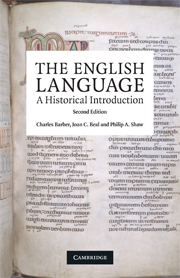Book contents
- Frontmatter
- Contents
- List of figures
- Preface to the second edition
- Preface to the first edition
- Map showing the counties of England
- 1 What is language?
- 2 The flux of language
- 3 The Indo-European languages
- 4 The Germanic languages
- 5 Old English
- 6 Norsemen and Normans
- 7 Middle English
- 8 Early Modern English
- 9 Late Modern English
- 10 English as a world language
- 11 English today and tomorrow
- Notes and suggestions for further reading
- Bibliography
- Index
2 - The flux of language
- Frontmatter
- Contents
- List of figures
- Preface to the second edition
- Preface to the first edition
- Map showing the counties of England
- 1 What is language?
- 2 The flux of language
- 3 The Indo-European languages
- 4 The Germanic languages
- 5 Old English
- 6 Norsemen and Normans
- 7 Middle English
- 8 Early Modern English
- 9 Late Modern English
- 10 English as a world language
- 11 English today and tomorrow
- Notes and suggestions for further reading
- Bibliography
- Index
Summary
Languages sometimes die out, usually because of competition from another language. For example, Norn, a Germanic language related to Old Norse, was introduced to Orkney and Shetland by Viking settlers, and spoken there until the eighteenth century. Its use began to decline from the fifteenth century, when Norway ceded the islands to Scotland, and Scots was increasingly used instead. When a language officially becomes ‘extinct’ is sometimes difficult to determine: for instance, many histories of English state that Cornish ‘died out’ in 1777 when the last native speaker died. However, a small number of speakers continued to use and write in the language, and by the middle of the nineteenth century a revival was in process. The revival gathered pace in the twentieth century, and, according to Ethnologue, a number of people now use it as first language, some 1,000 use it as their everyday language, and 2,000 others speak it fluently. Cornish is now recognized as an official language of the United Kingdom, and as a Minority Language within the European Union. A language can also become dead in another way. Nobody today speaks Classical Latin as spoken by Julius Caesar, or Classical Greek as spoken by Pericles, or the Old Icelandic spoken by the heroes of the Norse sagas. So Classical Latin and Classical Greek and Old Icelandic are dead languages. But, although dead, they have not died: they have changed into something else.
- Type
- Chapter
- Information
- The English LanguageA Historical Introduction, pp. 31 - 56Publisher: Cambridge University PressPrint publication year: 2009

